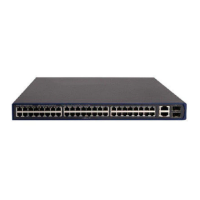111
• Remote source mirroring group configuration: configure a remote source mirroring group on the
source device, and configure the destination port in traffic mirroring (that is, Port A) as the egress
port. For the detailed configuration procedure, see the chapter “Port mirroring configuration.”
NOTE:
You should specify an arbitrary port as the source port. To prevent packets received/sent by the port from
bein
mirrored to the destination device by the remote source mirrorin
roup, confi
ure an unused por
as the source port.
Configurations on the destination device
You need only configure a remote destination mirroring group on the destination device. For the detailed
configuration procedure, see the chapter “Port mirroring configuration.”
Displaying and maintaining traffic mirroring
To do… Use the command… Remarks
Display user-defined traffic
behavior configuration information
display traffic behavior user-defined
[ behavior-name ] [ | { begin | exclude |
include } regular-expression ]
Available in any view
Display user-defined QoS policy
configuration information
display qos policy user-defined [ policy-name
[ classifier tcl-name ] ] [ | { begin | exclude |
include } regular-expression ]
Available in any view
NOTE:
For more information about the display traffic behavior and display qos policy commands, see
ACL an
QoS Command Reference
.
Traffic mirroring configuration example
Traffic mirroring configuration example
Network requirements
As shown in Figure 39:
• Different departments of a company use IP addresses on different subnets. The marketing and
technology departments use the IP addresses on subnets 192.168.1.0/24 and 192.168.2.0/24
respectively. The working hour of the company is from 8:00 to 18:00 on weekdays.
• Configure traffic mirroring so that the server can monitor the traffic that the technology department
sends to access the Internet, and IP traffic that the technology department sends to the marketing
department.

